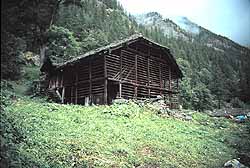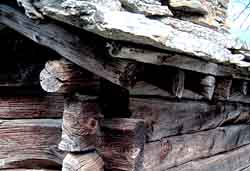I Walser

È una popolazione di origine germanica, stanziatasi dal XIII secolo nella zona del Monte Rosa, in Piemonte in alcuni paesi della Valsesia, Valle Strona, Val d’Ossola e in Valle d’Aosta nella Valle di Gressoney o del Lys.
L’aggettivo Walser deriva da Walliser, cioè del Vallese, cantone della Svizzera.
Nella zona d’origine queste popolazioni abitavano in alta montagna ed erano quindi abituati al freddo e ai lavori pesanti; abilissimi nel dissodare i terreni, sembra siano migrati verso il sud, occupando i terreni ancora vergini e li abbiano abilmente lavorati, in quanto spinti dagli scarsi mezzi di sostentamento, dalla sovrappopolazione e dalle continue calamità naturali delle loro regioni.
Il dialetto (Titschu), ovviamente simile al tedesco, con molte varianti lessicali tra i vari patois dei diversi insediamenti Walser, è parlato quasi esclusivamente dagli anziani e tra le nuove generazioni non si fa molto per mantenerlo in vita.
L’origine germanica è evidente nella toponomastica: Im Land (Alagna), Olter, Dorf, Remmu (Rima), Pomat (Formazza), Makannah (Macugnaga), Eischeme (Issime), Ekko, Alpenzu, Kastel.
L’architettura walser è molto caratteristica. La base delle costruzioni è in pietra, la parte superiore in legno, la copertura in spesse lastre di pietra (piode), che poggiano su possenti travi in legno. Al pian terreno vi è la cucina, il soggiorno, sovente una stalla per il ricovero invernale degli animali, un locale per la tessitura e la filatura; al primo piano si trovano le stanze da letto. La casa è circondata da un ampio loggiato in legno, che serve come essiccatoio per la segale o il fieno (la zona è molto piovosa ed è quindi difficile l’essiccazione nei prati o campi).
Tra le case vi sono stretti viottoli, coperti da tetti aggettanti per riparare dalla neve e pioggia; in ogni insediamento ci sono una cappella, una fontana in pietra, un forno comune, sovente anche il mulino.
L’interno della casa ha un arredamento molto razionale: panche fisse contro il muro, tavoli ribaltabili, armadi a muro, la caratteristica Stube, che serve a riscaldare l’intero ambiente.
Ad Alagna Valsesia, nella frazione Pedemonte vi è un bel museo nel quale vi sono ricostruiti gli ambienti della casa walser e raccolti gli attrezzi in uso nella vita quotidiana e nei lavori agricoli, con la denominazione in italiano e nel dialetto locale.
|
The Walser people

The Walser are a people of Germanic origin who reached in the XIII the Mt. Rosa area, in the piedmontese Sesia, Strona, Ossola valleys and in the Aostan Gressoney and Lys valleys.
The word Walser derives from Walliser, i.e. Valaise (a Swiss valley) inhabitant.
In their original area they were living in the high valleys, so being well accustomed to a cold climate and to heavy jobs, being at the same time exceptionally skilful in tilling the slopes. It seems that they were pushed southward, in order to take possess of not yet occupied lands, by the overpopulation and by the continuous natural disasters in their original territory.
The language (Titschu), obviously similar to the German, shows many local differences and is spoken quite only by the old people.
The German origin is self-evident in the toponymy: Im Land (Alagna), Olter, Dorf, Remmu (Rima), Pomat (Formazza), Makannah (Macugnaga), Eischeme (Issime), Ekko, Alpenzu, Kastel.
The Walser architecture is very characteristic. The base of the building is in stone, the upper part in wood, the roof-covering is made of thick stone slabs (piode) resting over strong wooden beams. At the ground-floor we can find the kitchen, the living-room, the cowshed (for the winter) and a room for hand-spinning and weaving; the sleeping rooms are on the first floor. The house is surrounded by a large open gallery to dry hay and rye, as the area is very rainy and it's very hard to dry them in the fields. Between the houses there are narrow passages, sheltered from rain and snow by the jutting roofs; every hamlet has a chapel, a stone fountain, a common oven, often also a mill.
The furniture is very rational: fixed benches along the wall, flapping tables, built-in wardrobes, and the typical Stube (stove) to warm the entire living area.
In the Pedemonte hamlet of Alagna Valsesia there is a nice museum where it is possible to visit the rooms of a typical Walser house and to take a look over the daily-life and agricultural tools. Names are both in the local language and in Italian.
|